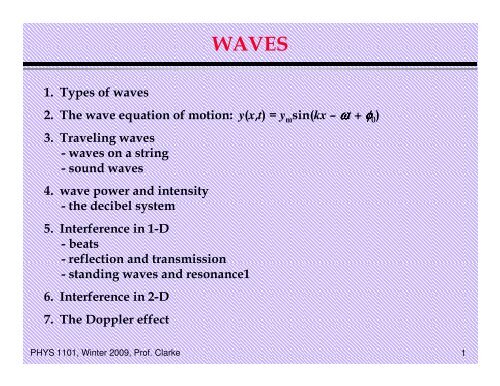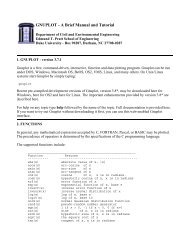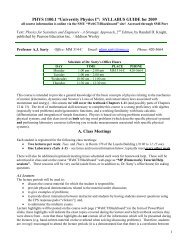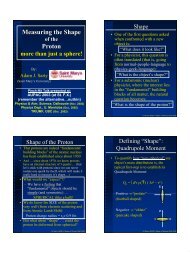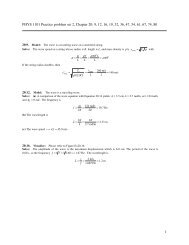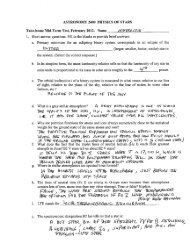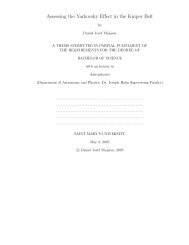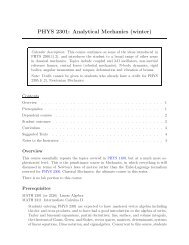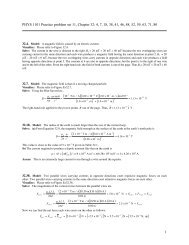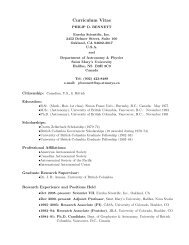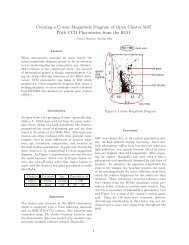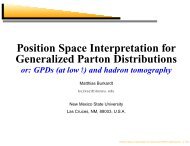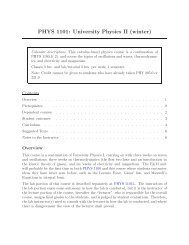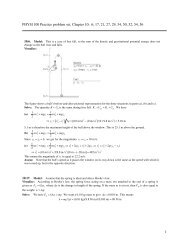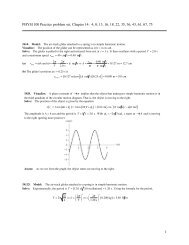1. Types of waves 2. The wave equation of motion: y(x,t) = ymsin(kx ...
1. Types of waves 2. The wave equation of motion: y(x,t) = ymsin(kx ...
1. Types of waves 2. The wave equation of motion: y(x,t) = ymsin(kx ...
You also want an ePaper? Increase the reach of your titles
YUMPU automatically turns print PDFs into web optimized ePapers that Google loves.
WAVES<br />
<strong>1.</strong> <strong>Types</strong> <strong>of</strong> <strong><strong>wave</strong>s</strong><br />
<strong>2.</strong> <strong>The</strong> <strong>wave</strong> <strong>equation</strong> <strong>of</strong> <strong>motion</strong>: y(x,t) = y m sin(<strong>kx</strong> – ωt + φ 0 )<br />
3. Traveling <strong><strong>wave</strong>s</strong><br />
- <strong><strong>wave</strong>s</strong> on a string<br />
- sound <strong><strong>wave</strong>s</strong><br />
4. <strong>wave</strong> power and intensity<br />
- the decibel system<br />
5. Interference in 1-D<br />
- beats<br />
- reflection and transmission<br />
- standing <strong><strong>wave</strong>s</strong> and resonance1<br />
6. Interference in 2-D<br />
7. <strong>The</strong> Doppler effect<br />
PHYS 1101, Winter 2009, Pr<strong>of</strong>. Clarke 1
Clicker question 1<br />
A simple harmonic <strong>wave</strong> is given by: y(x,t) = y m sin(<strong>kx</strong> – ωt + φ 0 )<br />
Consider the <strong>wave</strong> given by: y(x,t) = 2sin(πx – 2πt). Which <strong>of</strong><br />
the following functions correspond to this <strong>wave</strong>?<br />
a)<br />
2<br />
y<br />
x<br />
1<br />
2<br />
–2<br />
2<br />
–2<br />
4<br />
c)<br />
2<br />
y<br />
x<br />
b)<br />
1<br />
y<br />
x<br />
d)<br />
1<br />
y<br />
x<br />
–1<br />
2<br />
4<br />
–1<br />
π<br />
2π<br />
T = 2π/ω<br />
λ = 2π/k<br />
2<br />
–2<br />
4<br />
PHYS 1101, Winter 2009, Pr<strong>of</strong>. Clarke 2<br />
e)<br />
2<br />
y<br />
x
A simple harmonic <strong>wave</strong> is given by: y(x,t) = y m sin(<strong>kx</strong> – ωt + φ 0 )<br />
Consider the <strong>wave</strong> given by: y(x,t) = 2sin(πx – 2πt). Which <strong>of</strong><br />
the following functions correspond to this <strong>wave</strong>?<br />
a)<br />
2<br />
y<br />
Clicker question 1<br />
x<br />
1<br />
–2<br />
2<br />
2<br />
–2<br />
4<br />
c)<br />
2<br />
y<br />
x<br />
b)<br />
1<br />
y<br />
x<br />
d)<br />
1<br />
y<br />
x<br />
–1<br />
2<br />
4<br />
–1<br />
π<br />
2π<br />
T = 2π/ω<br />
λ = 2π/k<br />
2<br />
–2<br />
4<br />
PHYS 1101, Winter 2009, Pr<strong>of</strong>. Clarke 3<br />
e)<br />
2<br />
y<br />
x
What is the phase difference between a crest in a<br />
<strong>wave</strong>, and the adjacent trough?<br />
a) 0<br />
b) π/4<br />
c) π/2<br />
d) π<br />
e) 3π/2<br />
f) 2π<br />
Clicker question 2<br />
PHYS 1101, Winter 2009, Pr<strong>of</strong>. Clarke 4
Clicker question 2<br />
What is the phase difference between a crest in a<br />
<strong>wave</strong>, and the adjacent trough?<br />
a) 0<br />
y<br />
b) π/4<br />
c) π/2<br />
d) π<br />
0<br />
π/2<br />
π<br />
3π/2<br />
5π/2<br />
2π<br />
7π/2<br />
3π<br />
9π/2 φ = <strong>kx</strong><br />
4π<br />
e) 3π/2<br />
f) 2π<br />
PHYS 1101, Winter 2009, Pr<strong>of</strong>. Clarke 5
Clicker question 3<br />
What is the frequency <strong>of</strong> this travelling <strong>wave</strong>?<br />
a) 0.2 Hz<br />
b) 2 Hz<br />
c) 5 Hz<br />
d) 10 Hz<br />
e) 500 Hz<br />
PHYS 1101, Winter 2009, Pr<strong>of</strong>. Clarke 6
Clicker question 3<br />
What is the frequency <strong>of</strong> this travelling <strong>wave</strong>?<br />
a) 0.2 Hz<br />
b) 2 Hz<br />
c) 5 Hz<br />
d) 10 Hz<br />
e) 500 Hz<br />
v = fλ; λ = 10 m; f = v/λ = 5 Hz<br />
PHYS 1101, Winter 2009, Pr<strong>of</strong>. Clarke 7
Wavefronts<br />
Plane <strong><strong>wave</strong>s</strong> (1-D)<br />
Spherical <strong><strong>wave</strong>s</strong> (3-D)<br />
A<br />
r<br />
source<br />
Plane <strong><strong>wave</strong>s</strong> don’t spread,<br />
and the intensity, I = P/A,<br />
remains constant.<br />
Concentric spherical <strong><strong>wave</strong>s</strong> spread<br />
out over ever-larger area, A = 4πr 2 .<br />
With the same power, P, spread out<br />
over each sphere, the intensity, I, is:<br />
P P<br />
I =<br />
A<br />
=<br />
4πr 2 ⇒ I ∝ r –2<br />
PHYS 1101, Winter 2009, Pr<strong>of</strong>. Clarke 8
“Yardsticks” for the dB system<br />
β = 10 log(I/I 0 ) decibels (dB)<br />
threshold <strong>of</strong> human hearing<br />
rustling leaves<br />
conversation<br />
jack hammer<br />
rock concert<br />
threshold <strong>of</strong> pain<br />
jet engine<br />
10 log(I 0 /I 0 ) = 10 log(1) = 0 dB<br />
10 dB<br />
60 dB<br />
90 dB<br />
110 dB<br />
120 dB<br />
130 dB (can cause the ear to<br />
bleed)<br />
PHYS 1101, Winter 2009, Pr<strong>of</strong>. Clarke 9
Wave Interference<br />
<strong><strong>wave</strong>s</strong> approach…<br />
<strong>wave</strong> interference<br />
begins…<br />
constructive interference: crests<br />
and troughs <strong>of</strong> <strong><strong>wave</strong>s</strong> coincide<br />
maximum <strong>wave</strong><br />
interference…<br />
<strong>wave</strong> interference<br />
ends…<br />
<strong><strong>wave</strong>s</strong> recede as<br />
though nothing<br />
happened.<br />
destructive interference: crests <strong>of</strong><br />
one <strong>wave</strong> coincides with troughs<br />
<strong>of</strong> the other<br />
complete destructive interference:<br />
amplitudes <strong>of</strong> <strong><strong>wave</strong>s</strong> are also the<br />
same.<br />
PHYS 1101, Winter 2009, Pr<strong>of</strong>. Clarke 10
Beats (Fig. 21-31, Knight)<br />
y r<br />
T = 2π/ω<br />
T = 2π/ω<br />
Note that there are two “beats” in each period, T’.<br />
PHYS 1101, Winter 2009, Pr<strong>of</strong>. Clarke 11
Reflection and Transmission<br />
reflection, free end<br />
reflection, fixed end<br />
transmission, heavy → light<br />
transmission, light → heavy<br />
PHYS 1101, Winter 2009, Pr<strong>of</strong>. Clarke 12
Standing Waves<br />
PHYS 1101, Winter 2009, Pr<strong>of</strong>. Clarke 13
Clicker question 4<br />
Two loud speakers emit <strong><strong>wave</strong>s</strong> with λ = <strong>2.</strong>0 m. Speaker 2 is<br />
<strong>1.</strong>0 m to the right <strong>of</strong> speaker <strong>1.</strong> What, if anything, must be<br />
done to speaker 1 to cause constructive interference between<br />
the two <strong><strong>wave</strong>s</strong>?<br />
a) move it <strong>1.</strong>0 m to the right<br />
b) move it 0.5 m to the right<br />
c) move it 0.5 m to the left<br />
d) move it <strong>1.</strong>0 m to the left<br />
e) nothing; there is already<br />
perfect constructive interference<br />
between the two <strong><strong>wave</strong>s</strong><br />
PHYS 1101, Winter 2009, Pr<strong>of</strong>. Clarke 14
Clicker question 4<br />
Two loud speakers emit <strong><strong>wave</strong>s</strong> with λ = <strong>2.</strong>0 m. Speaker 2 is<br />
<strong>1.</strong>0 m to the right <strong>of</strong> speaker <strong>1.</strong> What, if anything, must be<br />
done to speaker 1 to cause constructive interference between<br />
the two <strong><strong>wave</strong>s</strong>?<br />
a) move it <strong>1.</strong>0 m to the right<br />
b) move it 0.5 m to the right<br />
c) move it 0.5 m to the left<br />
d) move it <strong>1.</strong>0 m to the left<br />
Remember, you must consider<br />
both the shift and the phase<br />
e) nothing; there is already<br />
perfect constructive interference<br />
between the two <strong><strong>wave</strong>s</strong><br />
PHYS 1101, Winter 2009, Pr<strong>of</strong>. Clarke 15
Clicker question 5<br />
Two sources <strong>of</strong> sound <strong><strong>wave</strong>s</strong> beat at 3 Hz. It is known that<br />
the frequency <strong>of</strong> one source is 610 Hz. <strong>The</strong>refore, the<br />
frequency <strong>of</strong> the other source must be:<br />
a) 604 Hz b) 607 Hz c) 613 Hz d) 616 Hz<br />
e) either b) or c) f) either a) or d)<br />
PHYS 1101, Winter 2009, Pr<strong>of</strong>. Clarke 16
Clicker question 5<br />
Two sources <strong>of</strong> sound <strong><strong>wave</strong>s</strong> beat at 3 Hz. It is known that<br />
the frequency <strong>of</strong> one source is 610 Hz. <strong>The</strong>refore, the<br />
frequency <strong>of</strong> the other source must be:<br />
a) 604 Hz b) 607 Hz c) 613 Hz d) 616 Hz<br />
e) either b) or c) f) either a) or d)<br />
f beat = f 2 – f 1 , the difference in the two frequencies.<br />
PHYS 1101, Winter 2009, Pr<strong>of</strong>. Clarke 17
Clicker question 6<br />
A standing <strong>wave</strong> vibrates as shown to<br />
the right. If the tension is quadrupled<br />
while keeping the frequency and length<br />
<strong>of</strong> string constant, which standing <strong>wave</strong><br />
pattern is produced?<br />
L<br />
a) b) c)<br />
no standing <strong>wave</strong><br />
for these conditions<br />
v = √T/µ = fλ<br />
d) e)<br />
PHYS 1101, Winter 2009, Pr<strong>of</strong>. Clarke 18
Clicker question 6<br />
A standing <strong>wave</strong> vibrates as shown to<br />
the right. If the tension is quadrupled<br />
while keeping the frequency and length<br />
<strong>of</strong> string constant, which standing <strong>wave</strong><br />
pattern is produced?<br />
L<br />
a) b) c)<br />
v = √T/µ = fλ<br />
⇒ λ ∝ √T<br />
no standing <strong>wave</strong><br />
for these conditions<br />
d) e)<br />
⇒ if T quadruples, λ<br />
doubles, and only one<br />
loop can fit inside L<br />
PHYS 1101, Winter 2009, Pr<strong>of</strong>. Clarke 19
Resonance (in pipes)<br />
Figure 2<strong>1.</strong>15, page 657, Knight<br />
PHYS 1101, Winter 2009, Pr<strong>of</strong>. Clarke 20
Wave Interference in 2-D<br />
Example problem<br />
λ<br />
S 1<br />
S 1<br />
r 1<br />
r 2<br />
S 2<br />
v<br />
d<br />
S 2<br />
r 1<br />
y<br />
“beach”<br />
“breakwater”<br />
r 2<br />
L<br />
lines <strong>of</strong> antinodes joins points <strong>of</strong> constructive<br />
interference (maximum amplitude)<br />
lines <strong>of</strong> nodes joins points <strong>of</strong> destructive<br />
interference (minimum amplitude)<br />
PHYS 1101, Winter 2009, Pr<strong>of</strong>. Clarke 21
Wave Interference in 2-D<br />
Example problem<br />
λ<br />
S 1<br />
v<br />
d<br />
S 2<br />
r 1<br />
y<br />
“beach”<br />
“breakwater”<br />
r 2<br />
L<br />
lines <strong>of</strong> antinodes joins points <strong>of</strong> constructive<br />
interference (maximum amplitude)<br />
lines <strong>of</strong> nodes joins points <strong>of</strong> destructive<br />
interference (minimum amplitude)<br />
PHYS 1101, Winter 2009, Pr<strong>of</strong>. Clarke 22
Wave Interference in 2-D<br />
Example problem<br />
λ<br />
S 1<br />
v<br />
d<br />
S 2<br />
r 1<br />
y<br />
“beach”<br />
“breakwater”<br />
r 2<br />
L<br />
lines <strong>of</strong> antinodes joins points <strong>of</strong> constructive<br />
interference (maximum amplitude)<br />
lines <strong>of</strong> nodes joins points <strong>of</strong> destructive<br />
interference (minimum amplitude)<br />
PHYS 1101, Winter 2009, Pr<strong>of</strong>. Clarke 23
Doppler Shift<br />
W 1<br />
W 6<br />
v S = 0<br />
S<br />
λ<br />
v D = 0<br />
D<br />
Nλ = c s ∆t<br />
PHYS 1101, Winter 2009, Pr<strong>of</strong>. Clarke 24
Doppler Shift<br />
W 1<br />
W 6<br />
S 1<br />
S 6<br />
v S<br />
S<br />
λ<br />
v D = 0<br />
D<br />
v S ∆t<br />
Nλ = (c s – v S )∆t<br />
Nλ = c s ∆t<br />
PHYS 1101, Winter 2009, Pr<strong>of</strong>. Clarke 25
Doppler Shift<br />
And did you hear the one about the rumoured (and fallacious) transcript <strong>of</strong> a<br />
conversation between US and Canadian authorities <strong>of</strong>f the coast <strong>of</strong><br />
Newfoundland…<br />
Canadians: Please divert your course 15 degrees south to avoid a collision.<br />
Americans: Recommend you divert your course 15 degrees north to avoid a collision.<br />
C: Negative. You will have to divert your course 15 degrees to the south to avoid a collision.<br />
A: This is the captain <strong>of</strong> a US Navy ship. I say again, divert your course.<br />
C: No sir, I say again, you will have to divert your course to avoid a collision.<br />
A: This is the aircraft carrier USS Lincoln, the second largest ship in the<br />
United States’ Atlantic fleet. We are accompanied by three destroyers, three<br />
cruisers, and numerous support vessels. I demand that you change your<br />
course by 15 degrees north. I say again, that’s one-five degrees north, or<br />
counter-measures will be undertaken to ensure the safety <strong>of</strong> this ship.<br />
C: This is a lighthouse. Your call.<br />
PHYS 1101, Winter 2009, Pr<strong>of</strong>. Clarke 26
Clicker question 7<br />
Two speakers are in phase and emit equal-amplitude sound<br />
<strong><strong>wave</strong>s</strong> with the same <strong>wave</strong>length <strong>of</strong> <strong>1.</strong>0 m. <strong>The</strong> interference<br />
<strong>of</strong> the two sound <strong><strong>wave</strong>s</strong> at point P can best be described as:<br />
P<br />
a) perfect constructive<br />
interference<br />
b) partial constructive<br />
interference<br />
c) partial destructive<br />
interference<br />
d) perfect destructive<br />
interference<br />
PHYS 1101, Winter 2009, Pr<strong>of</strong>. Clarke 27
Clicker question 7<br />
Two speakers are in phase and emit equal-amplitude sound<br />
<strong><strong>wave</strong>s</strong> with the same <strong>wave</strong>length <strong>of</strong> <strong>1.</strong>0 m. <strong>The</strong> interference<br />
<strong>of</strong> the two sound <strong><strong>wave</strong>s</strong> at point P can best be described as:<br />
P<br />
a) perfect constructive<br />
interference<br />
b) partial constructive<br />
interference<br />
c) partial destructive<br />
interference<br />
d) perfect destructive<br />
interference<br />
PHYS 1101, Winter 2009, Pr<strong>of</strong>. Clarke 28
Clicker question 8<br />
A source <strong>of</strong> sound, S, moves to the right as shown. In its<br />
own frame <strong>of</strong> reference, it emits a sound at frequency f 0 .<br />
Compare the frequencies that Amy and Zack hear.<br />
S<br />
a) f Amy < f 0 < f Zack b) f Amy > f 0 < f Zack<br />
c) f Amy > f 0 > f Zack d) f Amy = f 0 < f Zack<br />
e) f Amy = f 0 > f Zack f) f Amy = f 0 = f Zack<br />
PHYS 1101, Winter 2009, Pr<strong>of</strong>. Clarke 29
Clicker question 8<br />
A source <strong>of</strong> sound, S, moves to the right as shown. In its<br />
own frame <strong>of</strong> reference, it emits a sound at frequency f 0 .<br />
Compare the frequencies that Amy and Zack hear.<br />
S<br />
a) f Amy < f 0 < f Zack b) f Amy > f 0 < f Zack<br />
c) f Amy > f 0 > f Zack d) f Amy = f 0 < f Zack<br />
e) f Amy = f 0 > f Zack f) f Amy = f 0 = f Zack<br />
PHYS 1101, Winter 2009, Pr<strong>of</strong>. Clarke 30


